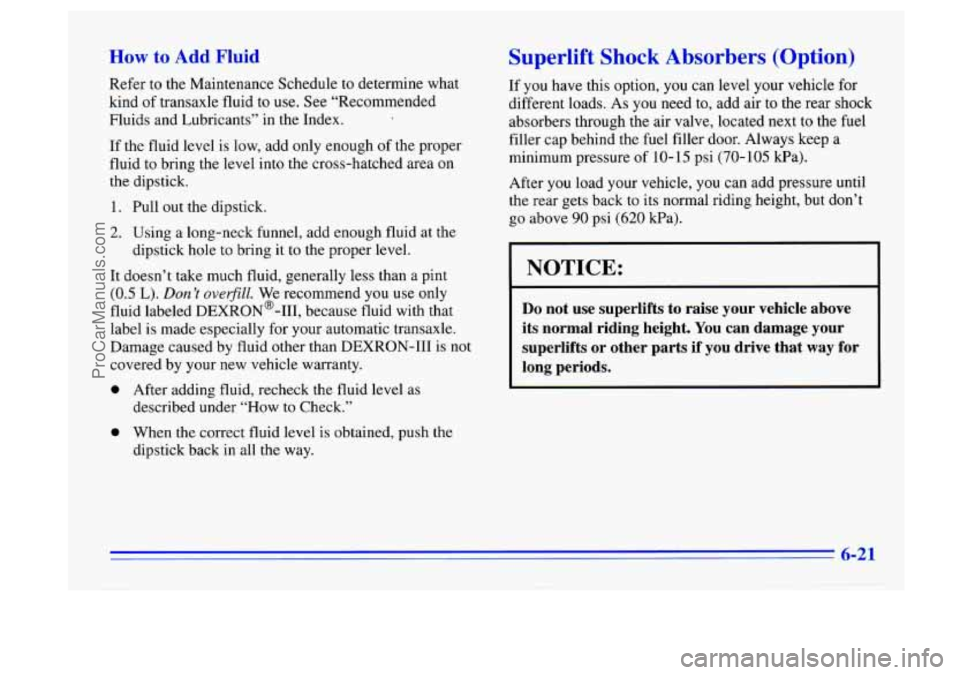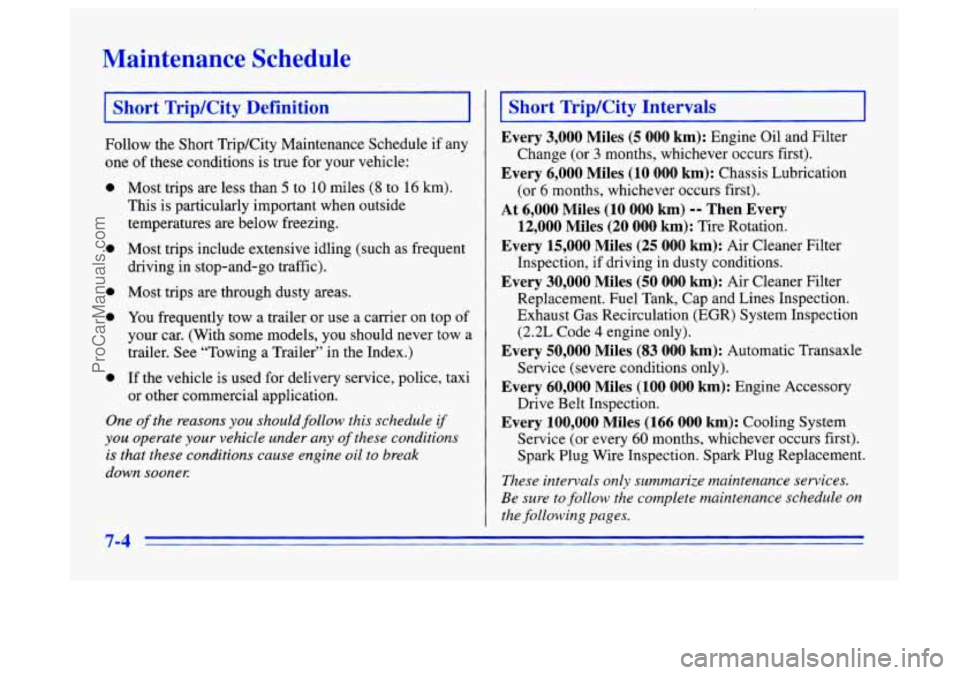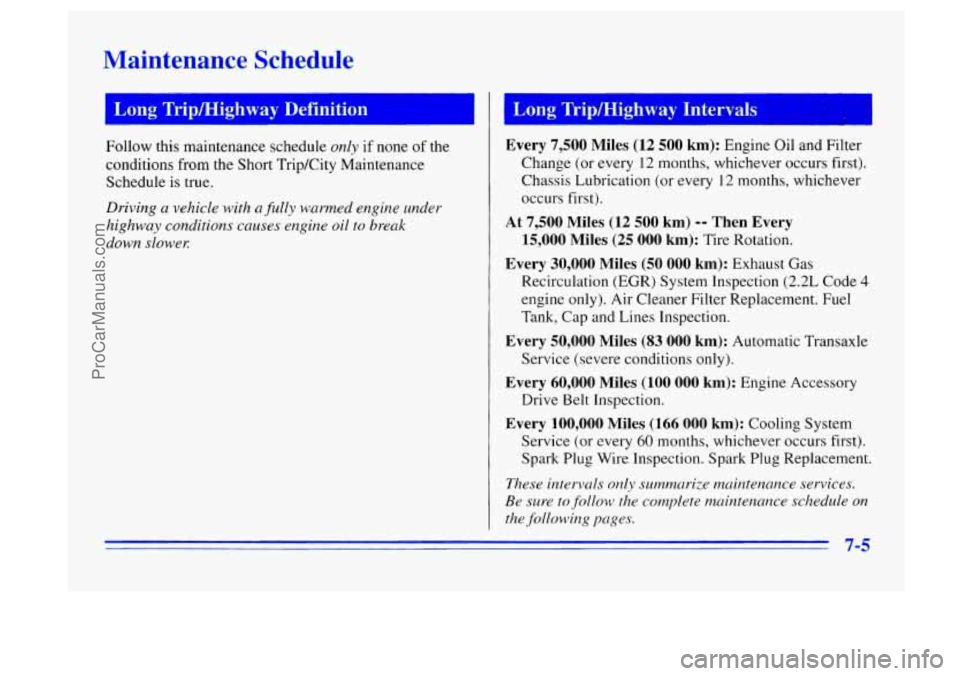Page 227 of 340

How to Add Fluid
Refer to the Maintenance Schedule to determine what
kind of transaxle fluid to
use. See “Recommended
Fluids and Lubricants” in the Index.
If the fluid level is low, add only enough of the proper
fluid to bring the level into the cross-hatched area
on
the dipstick.
1. Pull out the dipstick.
2. Using a long-neck funnel, add enough fluid at the
It doesn’t take much fluid, generally less than a pint
(0.5
L). Don’t overfiill. We recommend you use only
fluid labeled
DEXRON@-111, because fluid with that
label
is made especially for your automatic transaxle.
Damage caused by fluid other than
DEXRON-I11 is not
covered by your new vehicle warranty.
0 After adding fluid, recheck the fluid level as
dipstick hole
to bring it to the proper level.
described under “How to Check.”
0 When the correct fluid level is obtained, push the
dipstick back in all
the way.
Superlift Shock Absc :rs (Option)
If you have this option, you can level your vehicle for
different loads. As you need to, add air to the rear shock
absorbers through the air valve, located next to the fuel
filler cap behind the fuel filler door. Always keep
a
minimum pressure of 10- 15 psi (70- 105 kPa).
After you load your vehicle, you can add pressure until
the rear gets back to its normal riding height, but don’t
go above 90 psi (620 kPa).
NOTICE:
Do not use superlifts to raise your vehicle above
its normal riding height.
You can damage your
superlifts or other parts if you drive that way for
long periods.
ProCarManuals.com
Page 245 of 340

Inflation -- Tire Pressure
The Tire-Loading Information label, which is on the
rear edge of the driver’s door, shows the correct
inflation pressures for your tires when they’re cold.
“Cold” means your vehicle
has been sitting for at least
three hours or driven no more than 1 mile (1.6 km).
NOTICE:
Don’t let anyone tell you that, underinflation or
overinflation
is all right. It’s not. If your tires
don’t have enough air (underinflation), you can
get the following:
0 Too much flexing
Too much heat
0 Tire overloading
0 Bad wear
0. Bad handling
0 Bad fuel economy.
NOTICE: (Continued)
NOTICE: (Continued)
If your tires have too much air (overinflation),
you can get the following:
Unusual wear
Bad handling
Rough ride
Needless damage from road hazards.
When to Check
Check your tires once a month or more.
Don’t forget your compact spare tire.
It should be at
60 psi (420 Pa).
How to Check
Use a good quality pocket-type gage to check tire
pressure. You can’t
tell if your tires are properly inflated
simply by looking .at them. Radial tires may look
properly inflated even when they’re underinflated.
Be sure to put the valve caps back
on the valve stems.
They help prevent leaks by keeping out
dirt and moisture.
6-39
ProCarManuals.com
Page 268 of 340

Refrigerant (R=l34a), Air Conditioning*
2.2L (Code 4) .................................................... 1.75 lbs. (0.8kg)
3.1L V6 (Code
M) ................................................. 2.0 Ibs. (0.9kg)
*See “Air Conditioning Refrigerants” later in this section.
Power Steering
Pump Only 2.2L
L4 (Code 4) .................................................. 1 pint (0.47 L)
3.1L V6 (Code M) ................................................. 1 pint (0.47 L)
2.2L L4 (Code 4) ................................................ 1.7 pints (0.82 L)
Wheel Nut Torque ............................................ 100 lb-ft (140 N-m)
Type
...................................................... RH/LH 4.75 pin RRpin
Length
............................................... 18” (457 mm) 16” (406 mm)
Complete System
3.1L V6
(Code M) ................................................ 1.6 pints (0.75 L)
Windshield Wiper Blade Replacement
Fuel Tank
................
Tire Pressures, Sizes ........
NOTE: All capacities are approx
manual. .i
................................... 16.5
gallons 62.4 L
........ See Tire-Loading Information label on driver’s door.
mate. When adding, be sure to fill to the appropriate level, as recommended in this
6-62
ProCarManuals.com
Page 274 of 340

Maintenance Scl aule
1 Short Trip/City Definition 1
Follow the Short Trip/City Maintenance Schedule if any
one
of these conditions is true for your vehicle:
a
a
a
a
0
Most trips are less than 5 to 10 miles (8 to 16 km).
This is particularly important when outside
temperatures
are below freezing.
Most trips include extensive idling (such as frequent
driving
in stop-and-go traffic).
Most trips are through dusty
areas.
You frequently tow a trailer or use a carrier on top of
your car. (With some models, you should never tow a
trailer. See “Towing a Trailer” in the Index.)
If the vehicle is used for delivery service, police, taxi
or other commercial application.
One
of the reasons you should follow this schedule if
you operate your vehicle under any of these conditions
is that these conditions cause engine oil to break
down sooneE
Short Trip/City Intervals -
Every 3,000 Miles (5 000 km): Engine Oil and Filter
Change (or
3 months, whichever occurs first).
Every 6,000 Miles (10 000 km): Chassis Lubrication
(or
6 months, whichever occurs first).
At 6,000 Miles (10 000 km) -- Then Every
12,000 Miles (20 000 km): Tire Rotation.
Every 15,000 Miles (25 000 km): Air Cleaner Filter
Inspection, if driving in dusty conditions.
Every 30,000 Miles (50 000 km): Air Cleaner Filter
Replacement. Fuel Tank, Cap and Lines Inspection.
Exhaust Gas Recirculation (EGR) System Inspection
(2.2L Code 4 engine only).
Every 50,000 Miles (83 000 km): Automatic Transaxle
Service (severe conditions only).
Every 60,000 Miles (100 000 km): Engine Accessory
Drive Belt Inspection.
Every 100,000 Miles (166 000 km): Cooling System
Service
(or every 60 months, whichever occurs first).
Spark Plug Wire Inspection. Spark Plug Replacement.
These intervals only summarize maintenance services.
Be sure to follow the complete maintenance schedule on
the following pages.
7-4
ProCarManuals.com
Page 275 of 340

Maintenance Schedule
LOI- - Tripmighway Definition Long Tripmighway Intervals
Follow this maintenance schedule only if none of the
conditions from the Short TripKity Maintenance
Schedule is true.
Driving a vehicle with a fully warmed engine under
highway conditions causes engine
oil to break
down
slowel:
gvery -1,500 Miles (12 5UV km): Engine Oil and Filter
Change (or every
12 months, whichever occurs first).
Chassis Lubrication (or every
12 months, whichever
occurs first).
At 7,500 Miles (12 500 km) -- Then Every
15,000 Miles
(25 000 km): Tire Rotation.
Every 30,000 Miles (50 000 km): Exhaust Gas
Recirculation
(EGR) System Inspection (2.2L Code 4
engine only). Air Cleaner Filter Replacement. Fuel
Tank, Cap and Lines Inspection.
Every 50,000 Miles (83 000 km): Automatic Transaxle
Service (severe conditions only).
Every 60,000 Miles (100 000 km): Engine Accessory
Drive Belt Inspection.
Every 100,000 Miles (166 000 km): Cooling System
Service
(or every 60 months, whichever occurs first).
Spark Plug Wire Inspection. Spark Plug Replacement.
Tlzese interwls
ordv summarize maintenance services.
Be sure to~follow the complete maintenance schedule on.
the-following pages.
7-5
ProCarManuals.com
Page 281 of 340
I Short TripKity Maintenance Schedule 1
30,000 Miles (50 000 km)
0 Change engine oil and filter (or every
3 months, whichever occurs first).
An Emission Control Service.
0 Lubricate the parking brake cable guides,
underbody contact points and linkage. If
equipped with grease fittings, lubricate the
suspension and steering linkage (or every
6 months, whichever occurs first).
Replace air cleaner filter.
0 Inspect Exhaust Gas Recirculation (EGR)
An Emission Control Service.
system (2.2L Code 4 engine only).
An Emission Control Service. 3-
0 Inspect fuel tank, cap and lines for damage
or leaks. Inspect fuel cap gasket for
any damage. Replace parts as needed.
0 Rotate tires. See “Tire Inspection and
An Emission Control Service.
Rotation” in the Index for proper rotation
pattern and additional information. During
tire rotation, check brake calipers for
freedom of movement. Refer
to the
appropriate GM service manual for proper
caliper service procedures.
7-11
ProCarManuals.com
Page 287 of 340
I Short TripKity Maintenance Scheducl
60,000 Miles (100 000 km)
0 Change engine oil and filter (or every
3 months, whichever occurs first).
An Emission Control Service.
0 Lubricate the parlung brake cable guides,
underbody contact points and linkage.
If
equipped with grease fittings, lubricate the
suspension and steering linkage (or every
6 months, whichever occurs first).
0 Inspect engine accessory drive belt.
0 Replace air cleaner filter.
An Emission Control Service.
0 Inspect fuel tank, cap and lines for damage
or leaks. Inspect fuel cap gasket for any
damage. Replace parts as needed.
An Emission Control Service.
0 Inspect Exhaust Gas Recirculation (EGR)
system (2.2L Code 4 engine only).
An Emission Control Service.
DATE SERVICED BY: ACTUAL MILEAGE
7-17
ProCarManuals.com
Page 293 of 340
I Short TripKity Maintenance Schedule I
[7 Inspect fuel tank, cap and lines for damage or
leaks. Inspect fuel cap gasket for any damage.
Replace parts
as needed.
An Emission Control Service.
system (2.2L Code 4 engine only).
An Emission Control Service.?
0 Rotate tires. See “Tire Inspection and Rotation”
in the Index for proper rotation pattern and
additional information. During tire rotation,
check brake calipers for freedom of movement.
Refer to the appropriate
GM service manual for
proper caliper service procedures.
0 Inspect Exhaust Gas Recirculation (EGR)
I DATE I ACTUAL MILEAGE ISERVKED SEI
93,000 Miles (155 000 km)
0 Change engine oil and filter (or every
3 months, whichever occurs first).
An Emission Control Service.
ProCarManuals.com